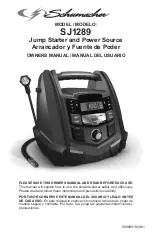
• 5 •
2.8
NOTE: This equipment has been tested and found to comply with the limits for a Class B digital device, pursuant to part 15 of the FCC Rules. These limits are designed to
provide reasonable protection against harmful interference in a residential installation. This equipment generates, uses, and can radiate radio frequency energy and, if not
installed and used in accordance with the instructions, may cause harmful interference to radio communications. However, there is no guarantee that interference will not
occur in a particular installation. If this equipment does cause harmful interference to radio or television reception, which can be determined by turning the equipment off
and on, the user is encouraged to try to correct the interference by one or more of the following measures:
• Reorient or relocate the receiving antenna.
• Increase the separation between the equipment and receiver.
• Connect the equipment into an outlet on a circuit different from that to which the receiver is connected.
• Consult the dealer or an experienced radio/TV technician for help.
3. FEATURES
1. Power button
2. Fault LED
3. Jump start/Override button
4. Light button
5. Ready LED
6. Battery status indicators
7. Battery clamps
8. 12V DC car charger
9. 100V-240V AC wall charger
10. DC input port
11. USB output port
12. Port cover
13. Built-in work light
8
9
6 1
2 3 4
5
7
10 11
12
13
4. CONTROL PANEL
4.1
LED INDICATORS
Battery status LED (GREEN) flashing: The internal battery is charging.
Ready LED (GREEN) solid: The unit is ready to jump start.
Ready LED (GREEN) flashing: The unit is ready to override.
Fault LED (RED) solid: Short circuit connected or clamps reversed.
4.2
FUNCTION BUTTONS
Power button: Press the button to turn on the power and check the battery status. Press the button and hold to turn on the work light.
NOTE: The unit will automatically turn off if not used for 30 seconds.
Light button: Press the button and hold to turn on the work light.
Jump start/ Override button: Press the button to jumpstart your vehicle. Press the button and hold for 5 seconds, to jump start your vehicle with low voltage.
5. CHARGING THE INTERNAL BATTERY OF THE JUMP STARTER
IMPORTANT: CHARGE IMMEDIATELY AFTER PURCHASE, AFTER EACH USE AND EVERY 30 DAYS, TO KEEP THE JUMP STARTER’S INTERNAL BATTERY FULLY
CHARGED AND PROLONG BATTERY LIFE.
5.1
CHECKING THE LEVEL OF THE INTERNAL BATTERY
Press the Power button on the front of the unit. The LEDs will indicate the current charge level as follows:
● ● ● ● 100% charged
● ● ● 75% charged
● ● 50% charged
● 25% charged
Charge the internal battery if the LEDs indicate less than 75%.
5.2
CHARGING THE INTERNAL BATTERY
The jump starter will fully charge in 3.5-4.5 hours (with 15V 3A charger).
NOTE: Use a 100V-240V AC wall charger to quickly recharge the jump starter. Using a charger with less than 3A will increase charge time.
1. Plug the AC wall charger into the input port.
2. Plug your charger into a live AC power outlet.
3. When the unit is fully charged, all four green LEDs turn solid for a short time, and then shut off.
4. When the battery is fully charged, disconnect your wall charger from the AC outlet and then remove the wall charger from the unit.
5. Charge the unit as soon as possible after use.
5.3
CHARGING THE INTERNAL BATTERY WHILE DRIVING
You may also charge the internal batteries while driving, using the 12V DC car charger (included). The jump starter will fully charge in 5.5-6.5 hours.
1. Make sure the car is running.
2. Plug the 12V DC adaptor cable into the unit’s 12V input socket.
3. Insert the other end of the accessory cable into the vehicle’s accessory outlet.
4. When the unit is fully charged, all four green LEDs turn solid for a short time, and then shut off.
5. When the battery is fully charged, disconnect your charger from the power source and then remove the charging cable from the charger and the unit.
6. Charge the unit as soon as possible after use.
NOTE: Completely disconnect the charger cable when the engine is not running.





























